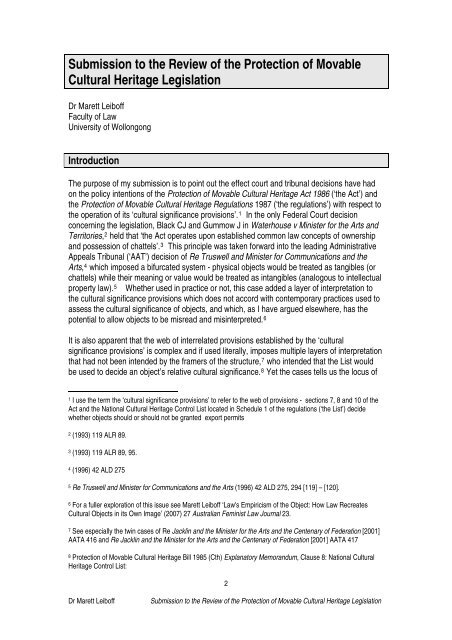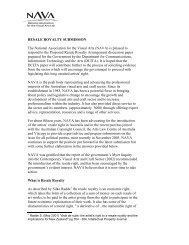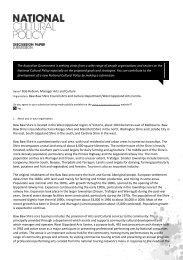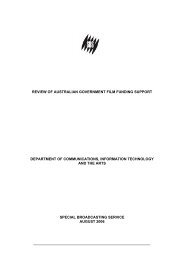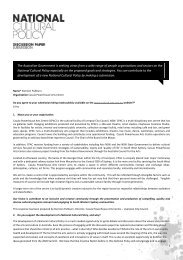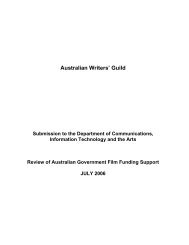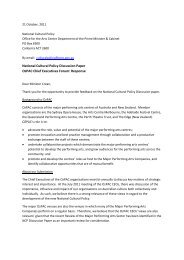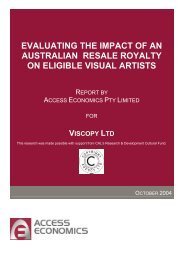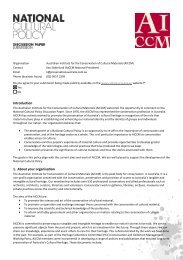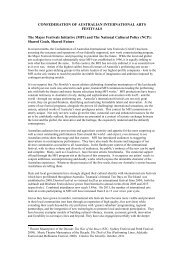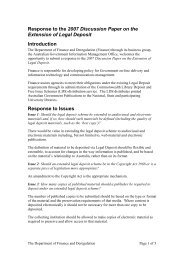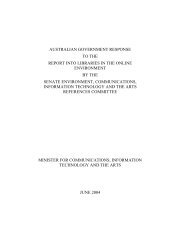Leiboff, Dr Marett (38 KB PDF)
Leiboff, Dr Marett (38 KB PDF)
Leiboff, Dr Marett (38 KB PDF)
You also want an ePaper? Increase the reach of your titles
YUMPU automatically turns print PDFs into web optimized ePapers that Google loves.
Submission to the Review of the Protection of MovableCultural Heritage Legislation<strong>Dr</strong> <strong>Marett</strong> <strong>Leiboff</strong>Faculty of LawUniversity of WollongongIntroductionThe purpose of my submission is to point out the effect court and tribunal decisions have hadon the policy intentions of the Protection of Movable Cultural Heritage Act 1986 (‘the Act’) andthe Protection of Movable Cultural Heritage Regulations 1987 (‘the regulations’) with respect tothe operation of its ‘cultural significance provisions’. 1 In the only Federal Court decisionconcerning the legislation, Black CJ and Gummow J in Waterhouse v Minister for the Arts andTerritories, 2 held that ‘the Act operates upon established common law concepts of ownershipand possession of chattels’. 3 This principle was taken forward into the leading AdministrativeAppeals Tribunal (‘AAT’) decision of Re Truswell and Minister for Communications and theArts, 4 which imposed a bifurcated system - physical objects would be treated as tangibles (orchattels) while their meaning or value would be treated as intangibles (analogous to intellectualproperty law). 5 Whether used in practice or not, this case added a layer of interpretation tothe cultural significance provisions which does not accord with contemporary practices used toassess the cultural significance of objects, and which, as I have argued elsewhere, has thepotential to allow objects to be misread and misinterpreted. 6It is also apparent that the web of interrelated provisions established by the ‘culturalsignificance provisions’ is complex and if used literally, imposes multiple layers of interpretationthat had not been intended by the framers of the structure, 7 who intended that the List wouldbe used to decide an object’s relative cultural significance. 8 Yet the cases tells us the locus of1 I use the term the ‘cultural significance provisions’ to refer to the web of provisions - sections 7, 8 and 10 of theAct and the National Cultural Heritage Control List located in Schedule 1 of the regulations (‘the List’) decidewhether objects should or should not be granted export permits2 (1993) 119 ALR 89.3 (1993) 119 ALR 89, 95.4 (1996) 42 ALD 2755 Re Truswell and Minister for Communications and the Arts (1996) 42 ALD 275, 294 [119] – [120].6 For a fuller exploration of this issue see <strong>Marett</strong> <strong>Leiboff</strong> ‘Law's Empiricism of the Object: How Law RecreatesCultural Objects in its Own Image’ (2007) 27 Australian Feminist Law Journal 23.7 See especially the twin cases of Re Jacklin and the Minister for the Arts and the Centenary of Federation [2001]AATA 416 and Re Jacklin and the Minister for the Arts and the Centenary of Federation [2001] AATA 4178 Protection of Movable Cultural Heritage Bill 1985 (Cth) Explanatory Memorandum, Clause 8: National CulturalHeritage Control List:2<strong>Dr</strong> <strong>Marett</strong> <strong>Leiboff</strong>Submission to the Review of the Protection of Movable Cultural Heritage Legislation


